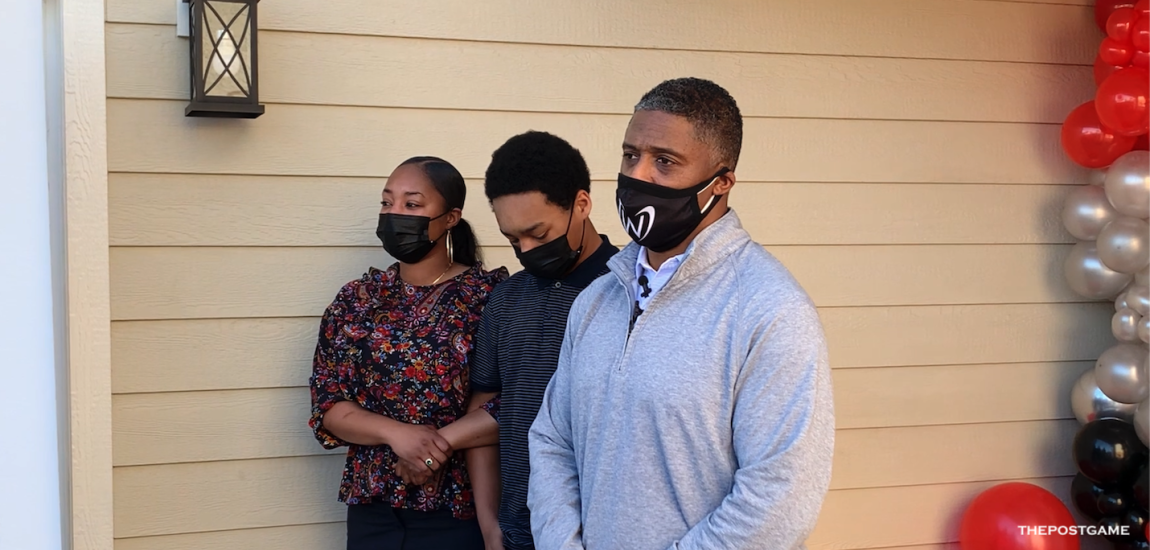
Nestled in Silicon Valley, a 27,000-square-foot green roof with 40 different species of local vegetation will rest atop the west side of the 49ers' new home, one of the most technologically sophisticated stadiums ever built.
The living roof will serve as the most recognizable feature of Levi's Stadium, which combines ecology and cutting-edge technology in a revolutionary way while embracing the Northern California culture.
"This really is the next generation of stadiums," said Scott Capstack, senior project designer at HNTB, the architecture firm that designed Levi's Stadium. "(The 49ers) want this to be the most connected stadium in the world."
Bolstered by some of the brightest minds from Facebook and other Bay Area tech companies, Levi's will offer free Wi-Fi, which allows all 60,000-plus fans to simultaneously connect. Its Wi-Fi infrastructure is designed to be 30 times faster than any other stadium.
"What we're building is the physical manifestation of Silicon Valley," 49ers president Paraag Marathe said.
This state-of-the-art stadium, however, is going in a bit of a different direction than the Cowboys' AT&T Stadium, the last NFL stadium to generate this kind of attention when it opened.
Called Cowboys Stadium when it opened in 2009, it featured four video screens, measuring 160 feet by 72 feet and 53 by 30.
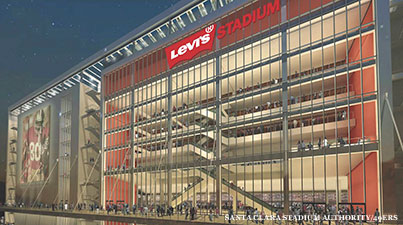
Although Levi's Stadium will have 13,000 square feet of video boards, in many ways the concept behind the 49ers' new home is opposite to AT&T Stadium. While JerryWorld is mammoth and enclosed, Levi's Stadium has a relaxed feeling with two 18,000-square-foot open plazas at the main entrances and just one upper deck.
"It's almost like football is inviting you in," Marathe said.
The inviting, open and eco-friendly feel is supposed to reflect the Bay Area -- almost like an airy San Francisco loft.
Instead of most concrete-laden versions that more resemble an airport terminal, from wherever you are in the Levi's Stadium main concourse, you will be able to see the field or the rolling hills in the distance.
Even the stadium's name is appropriate for the region.
CEO Jed York spurned more lucrative offers -- including two from major tech companies -- so that his arena would have a moniker befitting the 49ers nickname. Founded in San Francisco in 1853, Levi's originally sold durable work pants to gold miners.
"There's a direct connection between the company and the team's name," said Marc Ganis, president of SportsCorps Limited, a leading sports business consulting firm. "A historical connection."

Levi's Stadium also hearkens back further in the past because of its open-air design with raised seating.
"We even have used the analogy that the building's very similar to a Roman amphitheater," Capstack said. "It goes back to those very historical precedents."
Though it has some ancient principles, the cutting-edge project began in 2006.
Ribbon cutting for the $1.2 billion stadium is slated to take place July 17, and its debut will be August 2 when the San Jose Earthquakes host the Seattle Sounders FC in a soccer match.
With Wi-Fi so readily available at other large public areas -- airports, hotels, stores, etc. -- one would think enabling connectivity at a stadium would not be so difficult.
However, the amount of concrete and steel at arenas is problematic. (Think how your cell phone signal suffers when surrounded by skyscrapers, and Wi-Fi has an even weaker signal.) With a stadium having such a dense concentration of those materials, Wi-Fi signals struggle to penetrate it.
"It's an enormously challenging task to get that to 60 or 70,000 devices concurrently," Ganis said.
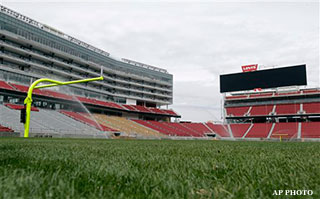
The heavy congestion of people, along with variable weather, further complicates the problem.
To address the connectivity issue, you not only need many antennas, but you also must have them evenly distributed.
That's easy to do in concourses and corridors but becomes tougher in the stands where antennas would obstruct sightlines, and there is less space to do so in the middle of a seating bowl.
To work on the technological backbone for Levi's Stadium, the 49ers have about 30 engineers and developers, and several have come from places like Brocade, Google, Yahoo! and Facebook.
Former 49ers chief technology officer Kunal Malik founded the IT department at Facebook. Vice president of technology Dan Williams, a former 49ers season-ticket holder, also hails from there.
"(Levi's Stadium) is kind of a beacon," Marathe said. "It's attracting a lot of Silicon Valley talent who want to be part of something special."
The 49ers declined to make Malik or Williams available for interview or specifically reveal how they have set up their network, so they could keep their trade secrets in house.

But it has been speculated that they will have hundreds of overlapping and hidden wireless access points distributed evenly around the fans.
"We've created a pretty novel spider web of access points," Marathe said. "Everybody that comes here is going to very pleasantly surprised with the quality of the Wi-Fi."
That Wi-Fi infrastructure will not only allow fans to check their fantasy football stats and post on social media, but also help drive the free Levi's Stadium app that is the main cog behind the new fan experience initiatives.
The app's features include:
- From any seat in the stadium -- not just those in club or high-priced seating -- you will be able to order food, beverages or merchandise, and runners will deliver the items. It is the first stadium to have that kind of all-encompassing service.
- Mere seconds after the play, you can watch high-definition replays, including those from multiple camera angles and in slow motion or regular time.
- The way-finding mechanism allows you to pin your car, so that you can find the fastest way to reach your seat or your friends, the closest concession stand and the bathroom with the shortest wait. The latter is denoted by a red, green and yellow lighted system.
- You can quickly buy tickets, exchange tickets, buy parking passes or transfer parking passes.
Just like the pirate ship at Raymond James Stadium or the hole in the roof at the old Texas Stadium, the green roof atop the suite tower will serve as Levi's Stadium's distinguishing feature.
"Every aerial shot will kind of showcase that," Marathe said.
Inspired by discovery museums, that living roof not only adds aestheticism but also has an ecological function, which provides insulation, limits water run-off and reduces the heat footprint.
The 49ers also tout the 20,000 square feet of solar panels in and around the stadium. Over the entire year, energy collected from those panels will be slightly greater than what is used during all 10 home contests.
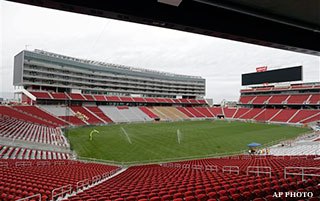
"If all we had was 49ers gamedays and nothing else in the stadium," Marathe said, "we are completely powered by the sun."
The turf is environmentally friendly as well. Staff will use recycled water to irrigate the field, and the Bermuda Bandera grass surface requires 50 percent less water than the average football field.
As a result of these measures, Levi's Stadium is on track to become the first NFL stadium to open with a Leadership in Energy & Environmental Design (LEED) gold rating from the U.S. Green Building Council.
The accreditation process, which is awarded via a tier level-like medal program, is based on a checklist of items, including carbon footprint reduction, material choices, solar power, recycling programs and accessibility to public transportation.
"(It) is a huge milestone," Capstack said.
Asked if the Oakland Raiders, who play in the dilapidated O.co Coliseum and are seemingly always looking for a new stadium, will ever play at Levi's -- similar to how the Jets and Giants share MetLife Stadium -- Marathe answered facetiously.
"Uh … let's see … in 2018, I believe we host the AFC West teams, so the Raiders will be coming," he said.
Though the Raiders may never use Levi's Stadium as their full-time home, downtown Oakland -- a little more than 40 miles away from the Santa Clara-based 49ers stadium -- is equidistant if not closer to Levi's than the financial district or heart of San Francisco proper.
Levi's Santa Clara location puts the 49ers farther from their own city than every other NFL stadium is from theirs (although the team's headquarters and practice facility has been in Santa Clara since the late 80s).
For more than a decade, the 49ers tried for a stadium in San Francisco, but the local political scene, which is notoriously unwelcoming to even traditional real estate, would not acquiesce.
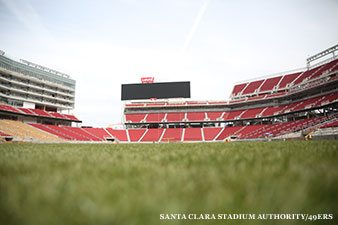
Marathe, though, said Levi's distance from San Francisco should not be an issue, stating that the 49ers have a significant number of their ticket holders residing along the peninsula, the East Bay, the South Bay and in Gilroy.
"One thing that's a little bit of a misnomer is that we're moving farther away from our season-ticket holders," Marathe said. "In many ways we're actually moving closer."
He also points out that the VTA light rail, ACE and Amtrak train opportunities and accessibly to the 237, 101 and 280 freeways may make for an easier and shorter commute than the 49ers' previous home, Candlestick Park, which had limited routes to and from the stadium.
But the NFL will not play non-holiday weeknight games in Levi's Stadium in 2014 because the team and local authorities want a year to figure out how to handle weeknight traffic flow into the stadium.
Once fans arrive there, Levi's has 24,000 parking spaces or about 6,000 more spaces than Candlestick had, according to Marathe.
However, Deborah Bress, spokeswoman for Santa Clara Plays Fair, a watchdog group for the 140,000-person city, vehemently disputes that and said that parking will become a major issue because Levi's Stadium is relying on spaces occupied by the nearby amusement park, which could have its own festivities going on.
"There is zero -- and I mean zero -- dedicated parking. They are 100 percent dependent on Great America," Bress said. "Tailgating's definitely in jeopardy."
Levi's Stadium will have 68,500 seats, though it can expand to 75,000 for special events.
The C-shaped stadium has just one upper deck, which are all sideline seats and opposite the suite tower, while two-thirds of the seats are in the lower bowl.
"There's really no bad seat in the house," Marathe said.

The 8,500 club seats cost about $250-300 per game. Each of the nine sections will have a different Bay Area theme. One will emphasize wine like Napa Valley; another has frosted glass to create a pattern reminiscent of San Francisco's famed fog.
"Each of the clubs themselves," Capstack said, "are unique and take cues from the surrounding region."
The 165 luxury boxes will feature tablets embedded in the wall for patrons to use, while team personnel for the 49ers, one of the more statistically-oriented NFL teams, will have a data analytics suite.
In and around the stadium, fans can scroll their phone over any piece of art, photo or icon to learn more about it, purchase a print or have it delivered to their home.
Despite the stadium's gadgetry and nice sightlines, ultimately the satisfaction of the 49ers fan base will be determined by how their team performs at this new stadium.
"The football game is still the hero," Marathe said. "The football game is still what people come to see."
Candlestick had been good to the 49ers, who won five Super Bowls while playing there from 1971-2013. The 49ers also have been to three straight NFC championship games with that as their home.
If the franchise continues to foster a winning atmosphere, perhaps it can reach Super Bowl L when Levi's Stadium hosts the ultimate game in 2016.
-- Yahoo! is the exclusive online sports content, social networking and photo and video sharing partner for Levi's Stadium. Follow Jeff Fedotin on Twitter @JFedotin.











